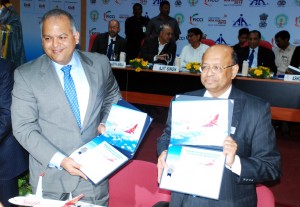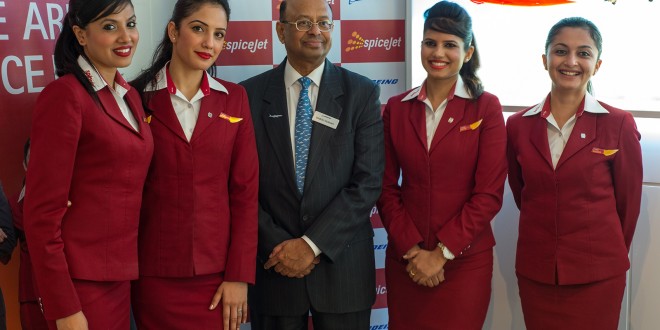The recent airshow at Dubai saw commercial airlines place aircraft orders in excess of $206 billion. This dollar value is greater than the total tax collection of the Indian Government for the last fiscal year. While the ordered airplanes start generating cash for airlines only after being put in to service, the airlines have to commence payments on these aircraft right from the time they sign the confirmed order contract all the way up to delivery.
This begs the question; given the low airline profitability in general and the large amounts of funds required for such orders, how are these orders financed?
PDPs commence from the moment a confirmed order contract is signed. Most buyers, whether an airline or leasing company, pay one percent of the list price of the aircraft along with the confirmed order. Further payments are made starting from about two years before till the aircraft is delivered, by which time the full cost of the aircraft is paid. While upfront cash and loans are an option, airlines are increasingly making use of PDP financing. With PDP financing airlines use debt as opposed to equity. That is, the airline is borrowing money to fund the payments rather than using its own cash, which consequently helps with better levels of working capital. PDPs can be financed up to the entire aircraft cost up to delivery, or a portion of the costs, with the airline paying the balance.
Benefits of PDP financing
Benefits of PDPs accrue to both the airline and the financiers. These are summarised in the table below:
| Airline / Leasing company |
Bank / financier |
| Reduced capital outflow while primary asset (i.e. aircraft) is not available | A secured debt with exposure to aviation assets |
| Ability to use cash/equity for other expenses | A short term opportunity with good returns |
| Ability to negotiate hefty discounts via large orders and induction of new airplane types | Often used as a first step towards longer term financing deals |
Overview of PDP financing

PDP financing is fairly complex and include a legal framework in order to address multiple scenarios. The lender may finance the total or a portion of the PDPs. At times, this may involve setting up a credit line from which the borrower (the airline) will make draw-downs as and when payments come due.
To simplify this, one can envision the PDP as essentially a secured loan. Therefore interest is payable throughout the term and the principal payable at the end (which is the delivery of the aircraft). The lender gets the first right on the aircraft i.e. a lien, very much like an individual finances a car.
There are at a minimum three parties to the PDP agreement – the manufacturer, the lender and the borrower. Each party in the PDP looks to minimize risk and this is done in the following way:
- For the lender the risk mitigation is via the first lien on the aircraft and a likely purchase price
- For the manufacturer the risk mitigation is via a manufacturer purchase option and/or the price guaranteed by the lender in case of a default
- For the borrower the risk mitigation is usually via penalty clauses in case of delay in deliveries
Elements of PDP financing
While overall agreements are complex, some of the key elements of PDP financing are:
- Purchase price: the price at which the lender can purchase the aircraft in the event of a default by the airline
- Purchase right (for the lender): the right of the lender to purchase the aircraft
- Assignment/ownership rights: the right of the lender to be assigned ownership of the aircraft and dispose the aircraft if required
- Purchase option (for the manufacturer): the right of the manufacturer to repurchase the aircraft rights in case of default by the airline
- Clawback: the situation where the manufacturer is forced to pay back the PDPs made in the event of a bankruptcy by the airline (usually enforced by courts)
Complexities in PDP financing
- PDP agreements by their very nature are extremely complex as they have to address multiple scenarios. In addition, they have to include legal structuring in various jurisdictions (for instance a PDP agreement with a French manufacturer, and Irish lessor, and an Indian carrier would have to incorporate elements of French, Irish and Indian laws and address potential conflicts too)
- Though airlines typically negotiate attractive prices for new orders, these are not revealed to PDP lenders. PDPs are actually on the base price and not the net price of the aircraft
- Purchase price for lenders is dynamic (not fixed) and is determined on the basis of a methodology outlined in the PDP agreement. There may be cases where the lender (in the event of a default by the borrower) may have to pay a higher price than the actual value of the aircraft in the prevailing market
- Purchase price for a lender can actually go up or down based on configuration and specification changes by the airline
Though the PDP finance is backed by an asset (the airplane), some banks argue that this is not a secured financing as the collateral is actually the lien on the asset. In some countries such as India, banks do not consider an aircraft to be an asset thus the lending is arguably without collateral.
Recent PDP financings
On average PDPs are in the range of 20% – 30% of the manufacturers list price. Some PDP financings are highlighted below:
| Year | Entity | Value | # Aircraft | Type of Aircraft |
| 2013 | Avia Capital | USD 278 mn | 50 | 737-800 |
| 2013 | Synergy group | USD 270mn | 8 | A330 |
| 2012 | Cargolux | USD 178mn | 6 | 747-8 |
| 2011 | Spicejet | USD 45mn | 15 | Q400 |
| 2008 | Air India | USD 200 mn | 8 | 777 |
The case against PDP financing
- As the global credit market has taken a downturn, in aviation finance PDP financing has borne a brunt of the blame and banks are increasingly reluctant to enter into these complex deals
- The argument is that inexpensive and easy PDP financing fuels large orders by airlines
- As the market trends downwards, in case of defaults (where lenders step in and purchase the aircraft) the inability to dispose the airplane adds to the lenders woes

Finally, some regulators question PDP deals and not everyone agrees that these are asset backed loans (which consequently creates challenges complying with the Basel II norms).
Outlook
- In the near term, PDP financing will continue to be challenging with a fewer banks willing to enter into and structure these agreements
- Interestingly, an economic downturn is where airlines most require PDP financings thereby leading to a challenging situation
- In jurisdictions like India, where fewer banks are offering PDP financings, airlines in the near term will likely have to pay a higher rates on new purchase orders
- The airline industry is well-known for the high levels of working capital required and drying up of PDP financing will exacerbate these challenges
- Emerging markets & frontier markets where fleet renewals are critical to domestic carriers will likely have to seek alternative means of funding in case of no improvement in the PDP market
This is the first in a series of articles that will address and attempt to explain some of the business, compliance and regulatory issues of the airline industry. Please share your thoughts on the article itself and whether you would like to see more articles like this. Lastly, Bangalore Aviation requests you to join us in welcoming Satyendra Pandey as a contributor to our site.
 Bangalore Aviation News, Reviews, Analysis and opinions of Indian Aviation
Bangalore Aviation News, Reviews, Analysis and opinions of Indian Aviation





Great insights on modern aircraft financing tools, well done Satyendra
Welcome Satya. This was an interesting read. Expectedly banks in India are a little wary of this, but how does PDP show on the airlines balance sheet. Wont it increase the debt component?